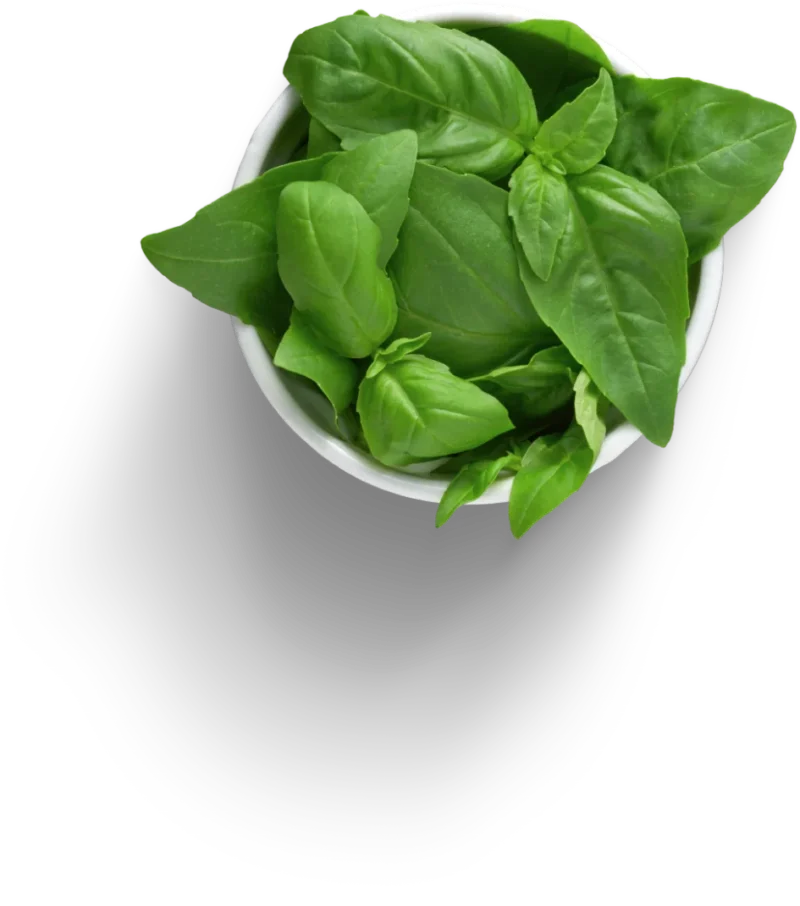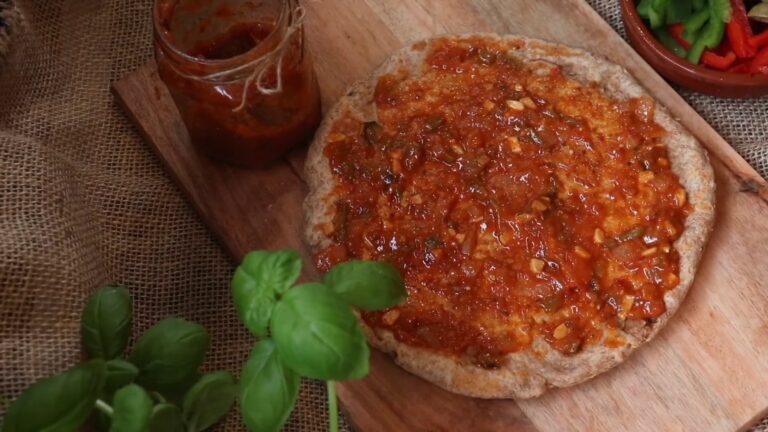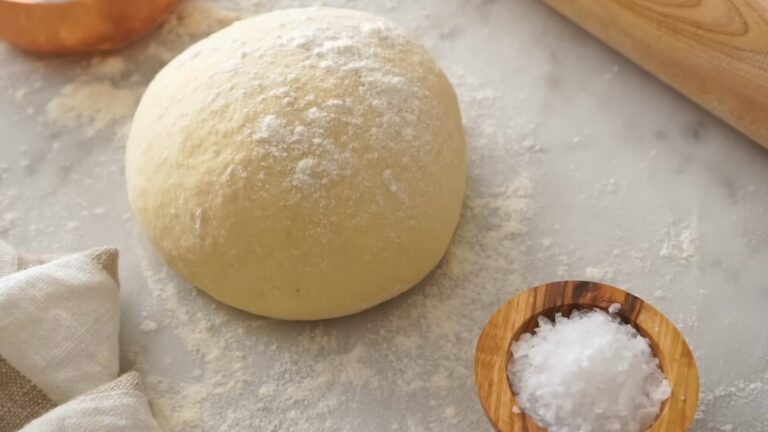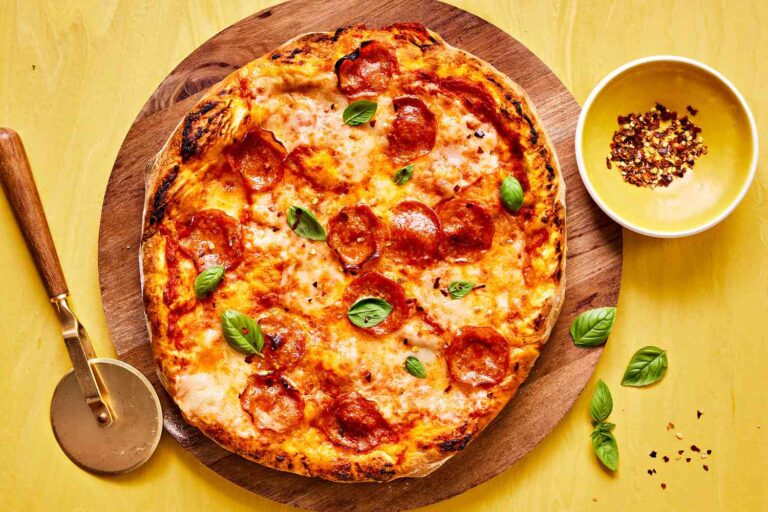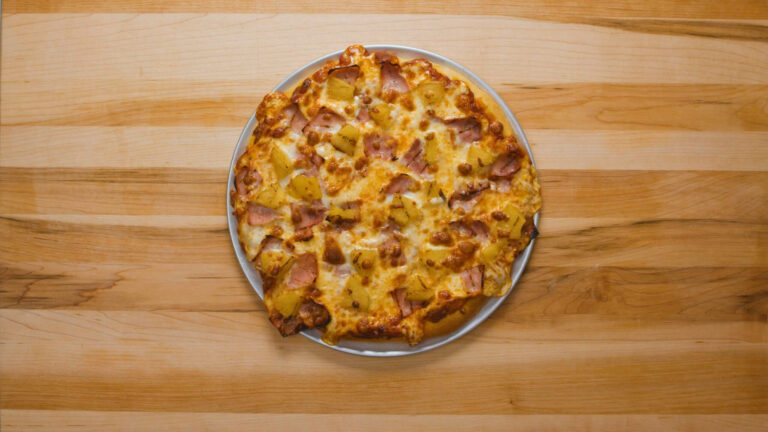The key to a perfect pizza crust lies in the choice of flour.
A lot of people are making the same mistake, thinking that the flour is not important and choosing to focus on other details of the recipe instead.
However, it can have a huge impact on the results.
I will share some of the most popular types of flour, and additional insights about which one I prefer the most.
1. All-Purpose Flour
When I want to get that crispy crust, all-purpose flour is my go-to choice. Its protein content, typically in the 9-11% range, strikes a perfect balance, making the dough both easy to work with and capable of achieving the wanted crispiness.
I often use it when I want a reliable and straightforward dough that doesn’t require special handling or ingredients, and it’s easily found in most stores.
Recipe Recommendation: Classic Margherita Pizza
- Ingredients: All-purpose flour, yeast, water, salt, olive oil, tomato sauce, fresh mozzarella, basil leaves, salt, and extra virgin olive oil.
- Preparation: Prepare a basic dough with flour, yeast, water, and salt. Stretch it into a thin base, then top with tomato sauce, slices of fresh mozzarella, and basil. Bake in a hot oven until the crust is crispy and golden.
2. Bread Flour
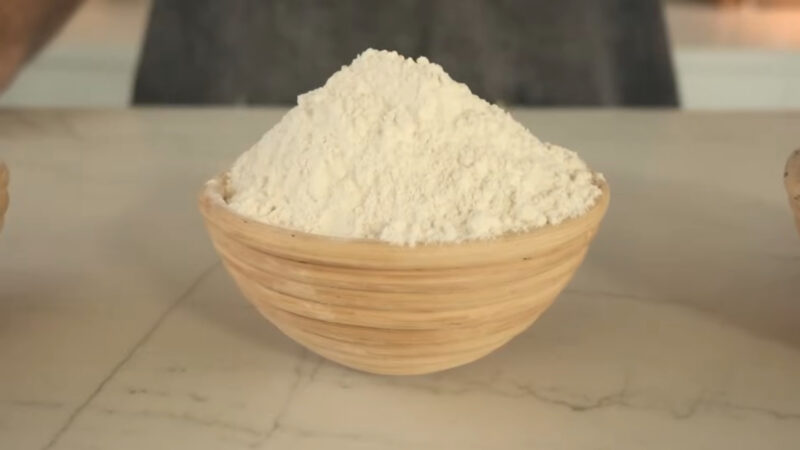
Do you like a pizza crust that’s got some chew to it instead of being flat and crunchy? Well, bread flour is where it’s at for that. See, bread flour’s got more protein than normal flour. That protein gives the dough some muscle, so when you bake it, the crust stays soft inside while getting crunchy outside.
It really comes through when you want a thick crust or load your pizza up with tons of toppings. This bread flour holds it all together instead of getting soggy. Biting into a slice, you get a nice texture change from the chewy crust that makes pizza way more fun to eat. It adds some excitement having the crust be more than just a vehicle for the toppings. Gives each bite some variety, you know?
Recipe Recommendation: New York-Style Pizza
- Ingredients: Bread flour, yeast, water, salt, sugar, olive oil, tomato sauce, shredded mozzarella, and your choice of toppings.
- Preparation: Make a slightly thicker dough using bread flour, yeast, water, salt, and a bit of sugar. Shape into large rounds, top with tomato sauce and a generous amount of shredded mozzarella, plus toppings like pepperoni or mushrooms. Bake until the crust is chewy and toppings are melted and bubbly.
3. 00 Flour
You making one of those true Neapolitan pizzas? Then you gotta use 00 flour, no question about it. See, 00’s got protein like bread flour but it’s ground super fine. That means the dough stretches nice and easy so you can toss it around.
At the same time, the protein gives the crust some structure so it doesn’t get soggy underneath all those toppings. When you cook it hot, that protein lets the crust get crispy on the outside while staying soft and chewy in the middle. That’s just what you want for an authentic Neapolitan pie!
The fine grind of 00 flour is key too. It lets the dough get light and airy inside while the outside chars up a little. After baking, you’ve got that perfect Neapolitan crust that’s a little charred but still tender.
Recipe Recommendation: Neapolitan Pizza
- Ingredients: 00 flour, yeast, water, salt, San Marzano tomatoes, fresh mozzarella, basil, olive oil, and sea salt.
- Preparation: Create a soft, stretchy dough with 00 flour. Form into small, thin bases. Top with crushed San Marzano tomatoes, chunks of fresh mozzarella, and basil. Cook in a very hot oven or pizza oven until the crust bubbles and chars slightly.
4. Whole Grain Flours
The whole grain flour is the way to go if you want your crust to have that real substance. See, whole grain flour’s got more protein than regular white flour. That extra protein means the crust holds its shape better when you’re chowing down.
It gives the crust a nice hearty texture that really fills you up. I think the whole grains also make it taste deeper and more complex than white flour too. Sometimes I’ll mix in a little white flour so it bakes up a bit lighter, but you still get that nice nutty whole grain flavor.
Plus, whole grain flour is way better for you with all the fiber and nutrients packed in there. If you ask me, it’s totally worth it for the taste AND nutrition. The chewiness really satisfies while keeping you feeling full.
Recipe Recommendation: Whole Grain Veggie Pizza
- Ingredients: Whole grain flour, yeast, water, salt, olive oil, assorted vegetables, tomato sauce, and grated cheese.
- Preparation: Mix whole grain flour with yeast, water, and salt to make a hearty dough. Roll out and top with tomato sauce, sautéed vegetables like bell peppers, onions, and mushrooms, and finish with grated cheese.
5. Almond Flour
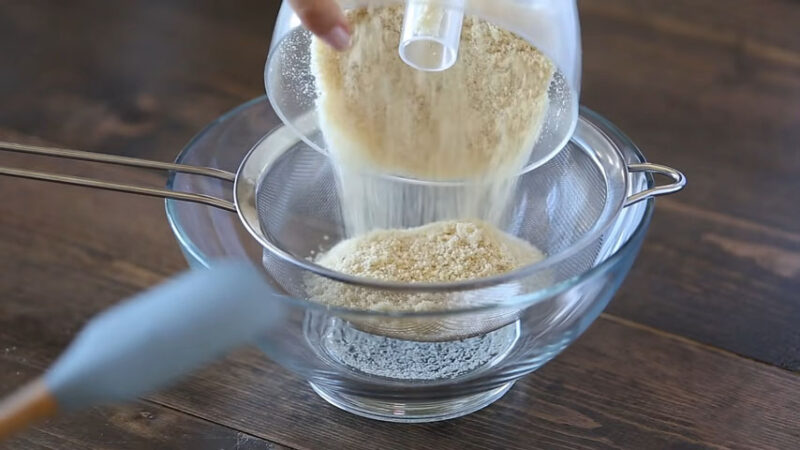
On a gluten-free diet? No problem – almond flour comes to the rescue! Almond flour bakes up real nice and thin, almost like a cracker. It’s perfect if you can’t have gluten but still want pizza.
The crust gets super crispy and light even though it’s made from nuts instead of wheat. And get this – it’s low-carb too since almonds are mostly fat and protein. I think the almond flavor mixes well with all kinds of toppings too, gives them a little extra something.
No one would even guess your “pizza” isn’t made with normal dough. Almond flour hides that it’s gluten-free so well. It’s my top pick any time someone needs a GF option that actually tastes good instead of like cardboard.
Recipe Recommendation: Keto Almond Flour Pizza
- Ingredients: Almond flour, egg, cream cheese, salt, olive oil, tomato sauce, mozzarella, and toppings like olives and ham.
- Preparation: Combine almond flour with egg and cream cheese to form a dough. Flatten into a thin crust, pre-bake for a few minutes, then add tomato sauce, cheese, and toppings. Return to the oven until the cheese is golden and bubbly.
6. Gluten-Free Flour Blends
As someone who often cooks for guests with dietary restrictions, gluten-free flour blends are a lifesaver. These blends are designed to mimic the texture of traditional pizza dough, making them an excellent choice for gluten-free pizzas.
They offer a flexible base for a range of toppings, ensuring that everyone can enjoy pizza night regardless of their dietary needs.
Recipe Recommendation: Gluten-Free Supreme Pizza
- Ingredients: Gluten-free flour blend, yeast, sugar, olive oil, tomato sauce, mozzarella cheese, pepperoni, bell peppers, onions, mushrooms.
- Preparation: Mix the gluten-free flour blend with yeast, sugar, and olive oil to form a dough. Knead and let it rise. Roll it out, add tomato sauce, then layer with cheese, pepperoni, and your choice of vegetables. Bake until the crust is crispy and the cheese is melted and bubbly.
7. Italian Tipo 0 Flour
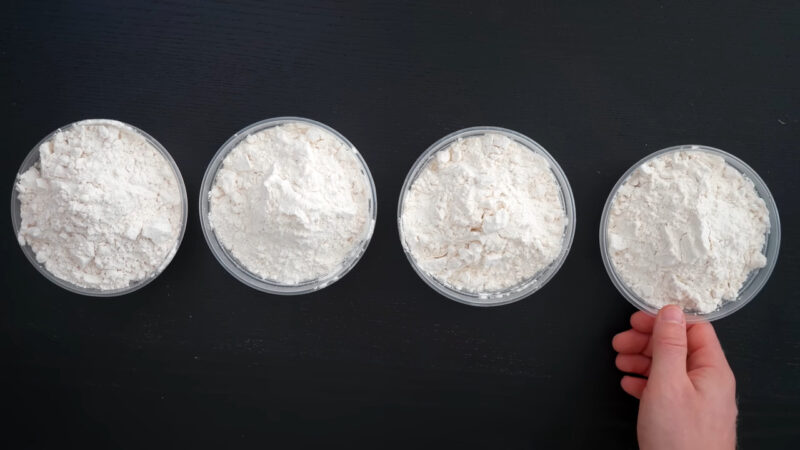
I prefer Italian Tipo 0 flour when aiming for a lighter thin crust. Its slightly coarser texture compared to Tipo 00 flour, along with a bit of wheat bran, contributes to a crust that is delicate yet holds up well under the heat.
I usually choose this flour when I’m looking for that thin crust with a slight crunch.
Recipe Recommendation: Thin Crust Vegetarian Pizza
- Ingredients: Tipo 0 flour, yeast, water, salt, tomato sauce, mixed bell peppers, red onions, mushrooms, mozzarella.
- Preparation: Mix Tipo 0 flour with yeast, water, and salt for the dough. After rising, roll it out thinly, apply tomato sauce, and top with mozzarella, bell peppers, onions, and mushrooms. Bake until the crust is crispy and the cheese is perfectly melted.
8. Type 1 Flour
You want a pizza crust with more flavor bang for your buck? Then check out Type 1 flour. See, Type 1’s still got the bran in it, which is the outer layer of the wheat with all the nutrients.
Because of that bran, Type 1 packs a ton of savory nutty taste that really stands out compared to regular white flour. The texture’s rustic too – thicker and chewier than white flour but not quite as hearty as whole grain.
If you’re tired of plain old crust and want some “personality,” Type 1 is the way to go. It makes each bite way more satisfying than a basic crust. Plus, it’s still healthier than white flour since some of those wholesome bran bits are in there.
Recipe Recommendation: Whole Wheat Pizza
- Ingredients: Type 1 flour, water, yeast, salt, olive oil, tomato sauce, goat cheese, sun-dried tomatoes, arugula.
- Preparation: Prepare dough with Type 1 flour, yeast, water, and salt. Let it rise, then shape and spread with tomato sauce. Top with dollops of goat cheese, sun-dried tomatoes, and bake. Finish with fresh arugula after baking.
9. Type 2 Flour
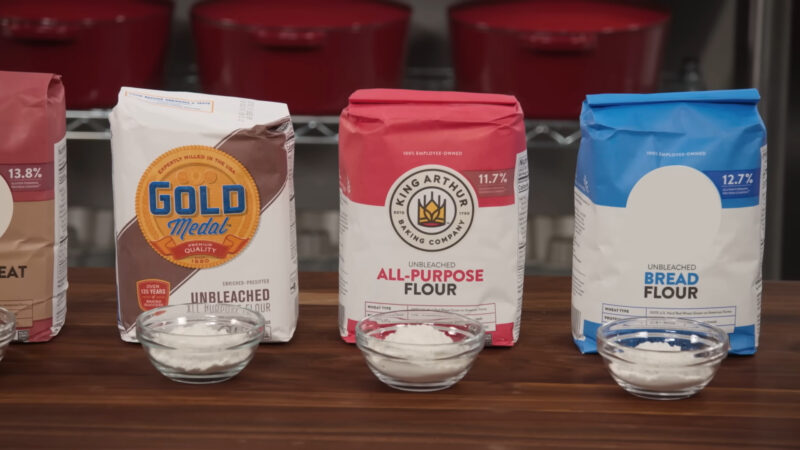
Type 2 flour is incredibly versatile and suitable for a range of pizza styles, from thin crust to deep dish. Its coarser grind and slightly darker color contribute to a crust that’s rich in flavor and varied in texture.
Depending on the water content and the kneading process, it can produce anything from a hearty, thick crust to a lighter, crisp base.
Recipe Recommendation: Rustic Deep-Dish Pizza
- Ingredients: Type 2 flour, yeast, olive oil, salt, tomato sauce, Italian sausage, bell peppers, onions, mozzarella.
- Preparation: Combine Type 2 flour with yeast, olive oil, and salt to make the dough. After rising, press it into a deep dish. Layer with tomato sauce, cooked Italian sausage, bell peppers, onions, and a generous amount of mozzarella. Bake until the crust is golden and the cheese is bubbly.
10. Semolina Flour
For pizzas with a perfectly crispy bottom and a chewy interior, semolina flour is my favorite. Made from durum wheat, it adds a unique texture and a golden color to the crust.
I often use it in combination with other flours to enhance the crust’s crispiness, especially when baking in a standard home oven.
Recipe Recommendation: Crispy Bottom Meat Lovers Pizza
- Ingredients: Semolina flour, all-purpose flour, yeast, olive oil, tomato sauce, pepperoni, cooked bacon, sausage, mozzarella.
- Preparation: Mix semolina flour with a bit of all-purpose flour, yeast, and olive oil for the dough. After rising, roll out, add sauce, and top with mozzarella, pepperoni, bacon, and sausage.
11. Manitoba Flour
Manitoba flour is hands down the best choice for deep dish pizzas. It got a super tough gluten structure so the dough holds itself together real well under a mountain of toppings.
It’s perfect when you need a crust that can support a lot of weight without getting soggy. I also find Manitoba flour works great when you do a long, slow ferment of the dough. That extra development time really lets the flavor shine through.
The crust ends up with complex, deep flavors that stand up to super rich toppings. It’s worth the wait, especially for thick crust styles.
Recipe Recommendation: Thick Crust Chicago-Style Pizza
- Ingredients: Manitoba flour, yeast, olive oil, salt, tomato sauce, ground beef, mushrooms, green peppers, mozzarella.
- Preparation: Make the dough with Manitoba flour, yeast, olive oil, and salt. Let it rise, then press into a deep dish. Start with cheese, then add cooked ground beef, mushrooms, and green peppers.
12. American Flours
American flours, like all-purpose and bread flour, are excellent choices for a variety of crusts due to their accessibility and versatility.
They’re a practical option for those who want to experiment with different pizza styles without the need for specialty flours.
It doesn’t matter if you’re going for a thin New York style or a thicker Sicilian crust, these flours can handle it all.
Recipe Recommendation: Classic American Pepperoni Pizza
- Ingredients: American bread flour, yeast, water, olive oil, tomato sauce, mozzarella cheese, pepperoni slices.
- Preparation: Prepare the dough using American bread flour, yeast, water, and olive oil. Let it rise, then shape, spread with tomato sauce, sprinkle with mozzarella, and arrange pepperoni on top.
13. Cake or Pastry Flour
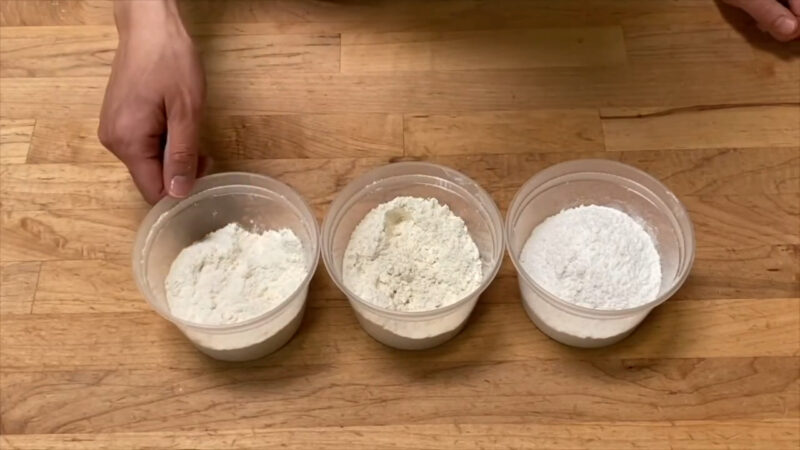
While not traditionally used for pizza, cake or pastry flour can create an interesting variation. Due to its low protein content, it’s less suitable for creating a classic pizza crust, often resulting in a softer, more tender bite.
It’s an unconventional choice for pizza, but it can be fun to experiment with for a different crust experience.
Recipe Recommendation: Soft Crust Cheese Pizza
- Ingredients: Cake flour, yeast, sugar, olive oil, tomato sauce, mozzarella cheese.
- Preparation: Combine cake flour with yeast, sugar, and olive oil to make a soft dough. After rising, roll out, top with tomato sauce and a generous amount of mozzarella.
14. Whole Wheat Flour
If you want your pizza crust to be good for you AND taste good, whole wheat flour is the way to go. It has more protein and fiber than regular flour. That gives the crust a nice hearty chew and also packs in nutrients.
The flavor’s great too – real nutty and complex. Only thing is, whole wheat by itself can make the crust a little too dense and tough. That’s why I like to mix it half and half with all-purpose or bread flour.
By blending the two, you get the best of both worlds. The white flour lightens it up texture-wise, and the whole wheat adds that awesome flavor and nutrition. The crust turns out hearty without being too thick and heavy. It’s the perfect balance if you want your pie to be a healthy treat.
Recipe Recommendation: Whole Wheat Veggie Pizza
- Ingredients: Whole wheat flour, yeast, olive oil, tomato sauce, spinach, bell peppers, red onions, feta cheese.
- Preparation: Mix whole wheat flour with yeast and olive oil to create the dough. Let it rise, then roll it out, add tomato sauce, and top with spinach, bell peppers, onions, and feta.
15. Oat Flour
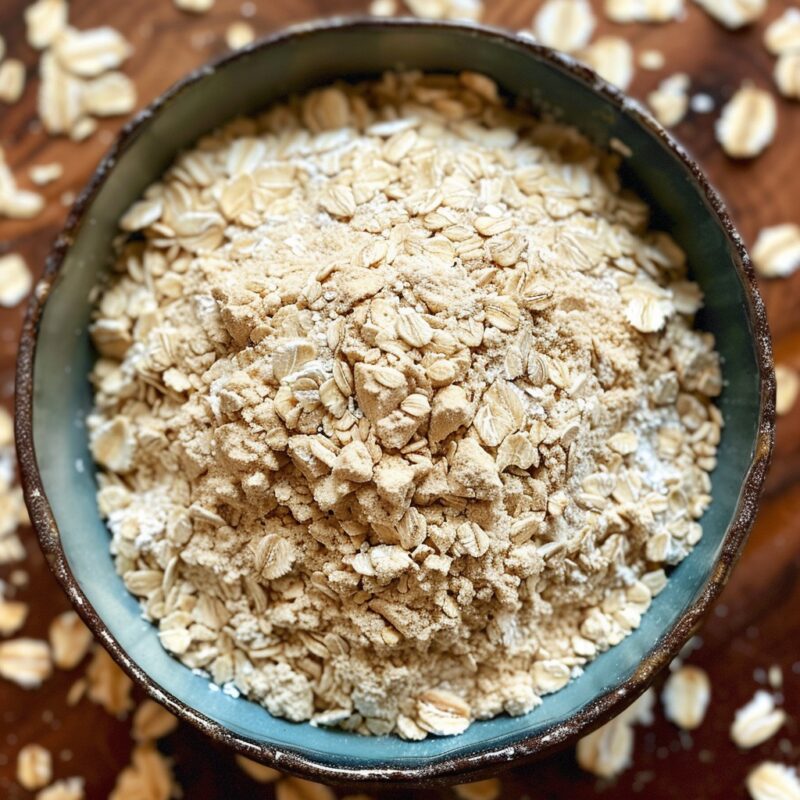
For a gluten-free and minimally processed option, oat flour is a fantastic choice. Its mild, nutty flavor adds a unique touch to the pizza crust.
Being gluten-free, it requires additional leavening agents to achieve the desired rise, but the result is a thin, flavorful crust that’s both healthy and delicious.
Recipe Recommendation: Gluten-Free BBQ Chicken Pizza
- Ingredients: Oat flour, yeast, olive oil, BBQ sauce, cooked chicken, red onions, cilantro, mozzarella cheese.
- Preparation: Create a dough with oat flour, yeast, and olive oil. Let it rise, then roll out and spread with BBQ sauce. Add cooked chicken, red onions, and mozzarella.
Final Thoughts
As you can see, the selection is quite wide, which means that anyone can easily adjust the taste of pizza to tiniest bits.
The first step, off course, is to learn how to prepare the dough at home.
With some practice and more experience, you will be able to recognize the favorite flour, and ensure the best results each time when you are making a homemade pizza.




